"Dil hai Hindustani"... aur cravings bhi? Well, you're not alone. We Indians take pride in our food. But did you know that the most popular desi delicacies like Rajma, naan, and samosa are not actually desi? True story!
Don't believe us? Check out the list- September, 2023
1. Samosa - Middle East
Deriving its roots from the 10th-century Middle East, samosa wasn't always an Indian go-to snack. Originally referred to as 'sambosa', this deep-fried savoury was a common staple of central Asian traders, who frequented India in the 14th century.
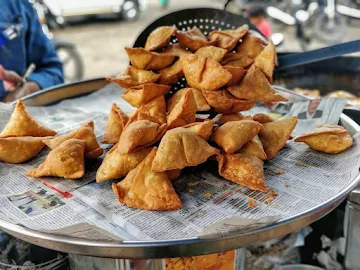
Image Courtesy: Restaurant Guru
Instructions:
- In a large mixing bowl, combine the all-purpose flour and salt. Add ghee or vegetable oil and mix well until the flour resembles breadcrumbs.
- Gradually add water, a little at a time, and knead the dough until it becomes firm and smooth. Cover the dough with a damp cloth and let it rest for 15-20 minutes.
- Meanwhile, prepare the filling. Heat some oil in a pan over medium heat. Add cumin seeds and let them splutter.
- Add the finely chopped onions and sauté until they turn translucent. Add the ginger-garlic paste and green chilies. Sauté for a minute or until the raw aroma disappears.
- Add the boiled and mashed potatoes, boiled green peas, coriander powder, red chili powder, garam masala, amchur powder, and salt. Mix well and cook for 2-3 minutes. Remove from heat and let the filling cool down.
- After the resting period, divide the dough into small lemon-sized balls. Take one ball and roll it out into a thin oval-shaped sheet. Cut the sheet into two halves.
- Take one half and fold it into a cone shape, overlapping the edges. Seal the edges using water as glue. Fill the cone with the prepared potato filling, leaving a small space at the top.
- Apply water on the open edges and press them firmly to seal the samosa. Repeat the process with the remaining dough and filling.
- Heat oil in a deep pan or kadai over medium heat for deep frying. Once the oil is hot, carefully slide in the prepared samosas, a few at a time.
- Fry the samosas until they turn golden brown and crispy on all sides. Remove them using a slotted spoon and place them on a kitchen towel to absorb excess oil.
- Serve hot samosas with mint chutney, tamarind chutney, or ketchup.
2. Rajma - Mexico
Even though rajma-chawal is a favourite North Indian jodi, Rajma actually came from Mexico. To tell you the truth, we owe the phenomena of soaking and boiling kidney beans for other delicious preparations to Mexico. It was introduced to us by the Portuguese centuries ago, but we managed to colour it desi. *sighs*
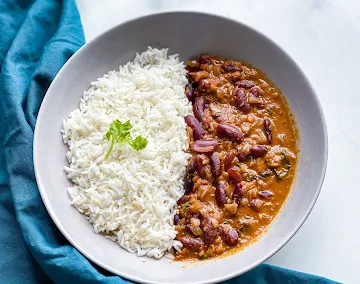
Image Courtesy: Soujanya Neekanti
Instructions:
- Wash the kidney beans (rajma) thoroughly under running water. Soak them in enough water overnight or for at least 8 hours. This will help in softening the beans and reducing the cooking time.
- After soaking, drain the water from the kidney beans and rinse them again. Transfer the beans to a pressure cooker and add enough fresh water to cover them. Add a pinch of salt, and cook on medium heat for about 15-20 minutes or until the beans are tender. Cooking time may vary depending on the type and age of the beans.
- Heat oil or ghee in a large pan or kadhai over medium heat. Add cumin seeds and let them splutter.
- Add the chopped onions to the pan and sauté until they turn golden brown.
- Add minced garlic, grated ginger, and slit green chilies. Sauté for a minute or until the raw aroma disappears.
- Add the pureed tomatoes to the pan and cook until the oil separates from the masala paste. This may take around 8-10 minutes.
- Now, add turmeric powder, red chili powder, coriander powder, and garam masala. Stir well to combine the spices with the masala.
- Pour in the cooked kidney beans along with the residual liquid. Mix everything together.
- Reduce the heat to low, cover the pan, and let the rajma simmer for about 20-25 minutes. This will allow the flavors to meld together and thicken the gravy.
- Check the consistency of the gravy and add water if required. Adjust the salt and spices according to your taste. Stir occasionally to prevent the rajma from sticking to the bottom of the pan.
- Once the rajma is cooked to the desired consistency and the flavors have developed, remove from heat.
- Garnish with freshly chopped coriander leaves.
3. Naan - Persia
Naan is a delicious flatbread variant that was never Indian. Introduced to the world by Persians, it came to India during the Mughal era. But since their rule was mostly confined to the northern part of the Indian subcontinent, naan enjoys its broad share of popularity in North India.
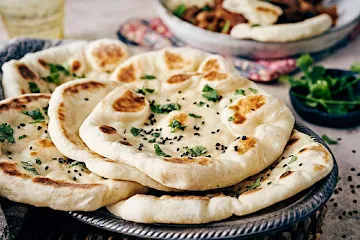
Image Courtesy: King Arthur Baking
Instructions:
- In a small bowl, combine the warm milk, sugar, and yeast. Stir gently and let it sit for about 5 minutes, or until the mixture becomes frothy.
- In a large mixing bowl, combine the all-purpose flour, salt, and baking powder. Mix well.
- Make a well in the center of the dry ingredients and pour in the yeast mixture, yogurt, and melted ghee or butter. Mix everything together until it forms a rough dough.
- Transfer the dough to a floured surface and knead it for about 5-7 minutes, or until it becomes smooth and elastic. You can add a little more flour if the dough is too sticky.
- Place the dough in a greased bowl and cover it with a clean kitchen towel. Let it rise in a warm place for about 1-2 hours, or until it doubles in size.
- Once the dough has risen, punch it down to release the air. Divide it into small equal-sized balls, about the size of a golf ball.
- Preheat a skillet or tawa over medium-high heat.
- Take one dough ball and roll it out into a tear-shaped or round naan, about 1/4 inch thick. Dust the surface with flour as needed to prevent sticking.
- Place the rolled naan onto the preheated skillet. Cook for about 1-2 minutes, or until you see bubbles forming on the surface.
- Flip the naan using tongs or a spatula, and cook the other side for an additional 1-2 minutes, or until golden brown spots appear.
- Remove the naan from the skillet and brush it with melted ghee or butter. Optionally, you can sprinkle nigella seeds or sesame seeds on top for added flavor.
- Repeat the process with the remaining dough balls, rolling and cooking each naan individually.
- Serve the naan warm, garnished with chopped fresh coriander leaves if desired. Naan pairs well with various curries and can be enjoyed as a side dish or used to scoop up other dishes.
4. Gulab Jamun - Persia
Native to another nation (in this case, Persia), gulab jamun DID NOT originate in India. And as shocking as it sounds, it's actually true. This delightful dessert was originally called 'luqmat al qadi' and even today the name is derived from the Persian language: gul - flower and ab - water. And yet, we love it.
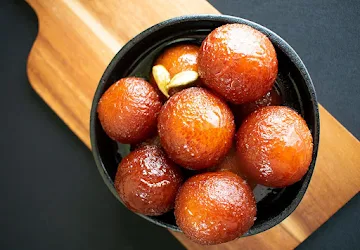
Image Courtesy: Spice and Colour
Instructions:
- In a mixing bowl, combine the milk powder, all-purpose flour, baking powder, melted ghee, and a pinch of cardamom powder. Mix well.
- Gradually add milk to the mixture, a tablespoon at a time, and knead it gently until it forms a soft and smooth dough. The dough should be slightly sticky but manageable. Be careful not to over-knead.
- Divide the dough into small portions and roll them between your palms to make smooth, crack-free balls. Make sure there are no cracks on the surface, as they might break while frying.
- Heat oil or ghee in a deep pan or kadhai over medium heat. The oil should be moderately hot. To check if it's ready, drop a small piece of dough into the oil; if it rises slowly to the surface, the oil is ready.
- Reduce the heat to low and carefully add the prepared Gulab Jamun balls to the hot oil. Fry them until they turn golden brown, stirring gently to ensure even browning. It usually takes about 8-10 minutes to fry them evenly.
- Once the Gulab Jamun balls are golden brown, remove them from the oil using a slotted spoon and drain the excess oil on a paper towel.
- In the meantime, prepare the sugar syrup. In a separate saucepan, combine sugar and water and bring it to a boil. Stir continuously until the sugar dissolves completely.
- Add saffron strands and cardamom powder to the syrup and let it simmer for about 5-7 minutes until it slightly thickens. Stir occasionally. If using, add rose water and mix well.
- Remove the syrup from heat and let it cool for a few minutes. Then, add the fried Gulab Jamun balls to the warm syrup. Allow them to soak for at least 30 minutes to an hour, or even overnight, so they absorb the syrup and become soft and spongy.
- Serve Gulab Jamun warm or at room temperature. They can be garnished with chopped nuts like almonds or pistachios if desired.
5. Tea - China
If your day is rendered pointless without a hot cup of tea, you definitely want to know this. Tea is as Indian as Chinese noodles! However, it wasn't the Chinese who introduced chai to us. In fact, Britishers brought tea to India in order to put an end to the tea monopolization by China. And we've been cultivating tea leaves since then. *wah Taj*
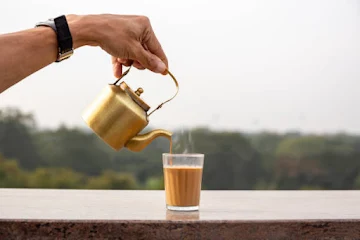
Image Courtesy: iStock
Instructions:
- In a saucepan, add water and bring it to a boil.
- Once the water is boiling, add the crushed cardamom pods, cloves, cinnamon stick, and grated ginger.
- Reduce the heat to low and let the spices simmer in the water for about 2-3 minutes. This helps to infuse the flavors into the water.
- Add the loose tea leaves or tea bags to the saucepan.
- Allow the tea to simmer in the water and spices for about 2 minutes on low heat.
- Add milk to the saucepan and increase the heat to medium.
- Let the tea come to a gentle boil while stirring occasionally to prevent the milk from overflowing.
- Once the tea comes to a boil, reduce the heat to low and simmer for an additional 2-3 minutes.
- Add sugar according to your taste preferences and stir well until it dissolves completely.
- Turn off the heat and strain the tea using a fine mesh strainer into a teapot or cups.
- Serve the hot and aromatic Indian Tea, also known as Masala Chai, and enjoy!
6. Jalebi - Middle East
As much as it pains us to say this, Indians weren't behind the creation of one of the most scrumptious desserts of all time.Jalebi shares its lineage with samosa and other Middle Eastern grubs. Originally called 'zalabiya' in Arabic or the 'zalibiya' in Persian, jalebi was brought to India by the Persian invaders. Thank you, guys!
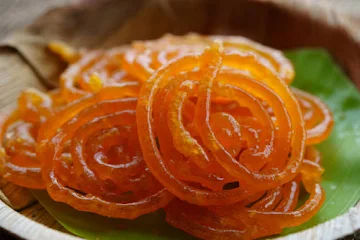
Image Courtesy: iStock
Instructions:
- In a mixing bowl, combine the all-purpose flour, gram flour, turmeric powder, and baking powder. Mix well.
- Gradually add warm water to the dry ingredients and whisk to form a smooth batter. Make sure there are no lumps. The batter should be thick but pourable.
- Add fennel seeds and yogurt to the batter. Mix well and let the batter rest for about 15-20 minutes.
- In a separate saucepan, heat the sugar and water for the syrup over medium heat. Stir until the sugar dissolves completely. Add cardamom powder and saffron strands. Simmer the syrup for about 5 minutes until it slightly thickens. Stir in the lemon juice and turn off the heat. Keep the syrup warm.
- In a deep frying pan or kadai, heat vegetable oil on medium-high heat for deep frying. Add ghee to the oil, which helps in making the jalebis crisp.
- Pour the batter into a squeeze bottle or a piping bag with a small nozzle. The nozzle should have a small opening for thin jalebis.
- Squeeze the batter into the hot oil in a circular motion, starting from the center and moving outward. You can make small or large circles, depending on your preference.
- Fry the jalebis until they turn golden brown and crispy. Make sure to flip them over to cook evenly on both sides. Remove them from the oil using a slotted spoon and drain the excess oil.
- Immediately immerse the fried jalebis into the warm syrup. Let them soak for about a minute, then remove and transfer to a serving plate. Repeat the frying and soaking process with the remaining batter.
- Serve the jalebis warm or at room temperature. They taste best when fresh and crispy.
You can take these dishes out of India but cannot take Indian out of these dishes.